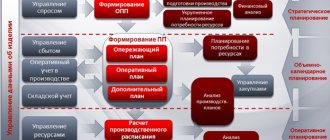For a ship that has no course,
no wind will be favorable.
Ancient Roman philosopher
and statesman Seneca
Where to start developing a strategic plan?
What sections must be present in the strategic plan?
What methods can be used to check the correctness of the strategic development plan?
How to analyze the external and internal context of an organization?
How to formulate a mission and develop development strategies for an organization?
How to develop a business plan for the development of an organization?
How to ensure the implementation of the strategic development plan?
How to ensure the relationship between strategies, business development plans and budgets of the organization?
A company that does not have strategic development goals and specific plans to achieve them is doomed to follow current events with very vague prospects for the future. But developing a correct strategic development plan requires management to have high competencies and skills, since it involves not so much calculating business performance indicators as forecasting business dynamics, taking into account the risks and opportunities associated with both the external and internal context of the organization.
You can often come across the opinion that strategic planning is needed by large companies that have already declared themselves as leaders in their market segment and look to the future with confidence.
But, firstly, any company has a specific goal for its activities and at least an approximate business plan. And these are already elements of strategic planning.
Secondly, even novice entrepreneurs assess the size of the market in which they are going to operate, the competitive environment and their ability to enter this market. That is, they engage in strategic analysis, which is also one of the components of strategic planning.
In other words, most small and medium-sized companies in fact also use strategic planning, but, unlike large players in the market, they do it unsystematically and not in full.
And even in large companies it happens that strategic development plans developed with a lot of time and effort remain just plans. This can be caused by many external and internal factors, the most common of which are the lack of integrity in the planning methodology and disruption of the relationships between strategies, business development plans and company budgets.
We offer a methodology for developing the most effective strategic development plan and recommendations that will help avoid possible risks of erroneous forecasts, we will tell you about the sequence of forming a strategic development plan, and we will reveal the relationship between the context, goals and resources of the company, which should be reflected in the strategic development plan.
Of course, the strategic development plans of large, medium and small companies will differ due to the difference in the scale of economic activity, the specifics of the business, the complexity of the organizational structure and business processes.
But in any case, a well-developed strategic development plan is formed on the basis of sequentially implemented stages:
Analysis of the external and internal context of the organization
The performance of any company is influenced by many different factors. Without understanding the extent of their impact, it is impossible to develop the right strategic direction for the company's development.
The company itself also influences the external environment (context) - the product market, suppliers, buyers, partners, regulatory authorities, etc.
Note!
How successfully a company's strategy will be implemented largely depends on its ability to organize its internal environment (context), which includes business processes, organizational resources, personnel, structure and production technologies, as well as corporate culture and principles.
The combination of factors in a company’s internal context largely determines its competitiveness.
Therefore, before developing a mission and strategy, it is necessary to conduct a strategic analysis of the external and internal context of the company, the result of which should be an assessment of the risks and opportunities of a particular enterprise in its surrounding market environment.
The 3 most common methods of strategic analysis:
- SWOT analysis;
- construction of Probability/Impact matrices;
- creating a register of risks and opportunities.
The purpose of SWOT analysis (Strength - strength, Weak - weakness, Opportunity - opportunities and Threat - threats) is to determine the strengths and weaknesses of the company, to establish their connections with external opportunities and threats.
Based on the results of the analysis, company strategies are developed aimed at using opportunities and eliminating threats to development.
“Probability/Impact” matrices are built separately to position the opportunities of the company’s external environment and to position the threats to the company’s external environment.
In each of the matrices, opportunities and threats are distributed according to the likelihood of their occurrence and the strength of their impact on the company.
Matrices help control external factors and develop business development strategies.
Creating a register of risks and opportunities involves a more detailed analysis compared to the two previous methods. First, risks and opportunities in both the external and internal contexts of the company are identified. Next, the identified risks and opportunities are assessed according to the likelihood of their implementation and the degree of impact on the company’s business. Then a matrix of risks and opportunities is formed, which reflects the total degree of influence of the assessed risks and opportunities (“High”, “Medium”, “Low”). The final stage is drawing up a register of risks and opportunities. It records all the risks and opportunities that are significant for the company, ways to minimize and implement them (essentially, these are the company’s strategies), as well as the responsible (owners) of each of the risks and opportunities.
Conclusion
When choosing a development strategy, a company should focus on its strengths (high quality products, customer service, positive business reputation) to take advantage of business expansion opportunities (increasing sales, releasing a new type of product, providing additional services to customers).
At the same time, it is necessary to strengthen its weaknesses (depreciation of funds, insufficient qualifications of personnel, dependence on loans) in order to minimize the risk of external threats (rising prices for raw materials, increasing competition in the market, decreasing consumer demand).
Since the time required to develop an investment project is quite large (for example, in a medium-sized enterprise, it takes about two working months for management staff to draw up a business plan), the lack of consultants can negatively affect the ability to carry out operational management functions. [p.554] Without a radical restructuring of structures management of the company will not be able to become competitive. It is necessary to develop a marketing policy, transform the thinking of enterprise managers who in the past focused only on solving production and technological problems, switching their attention to financial, sales conditions, and effective marketing. Some Russian enterprises are already carrying out serious organizational and managerial changes , in particular, the reorganization of marketing and sales along product lines, the use of project, matrix and network structures.The new organization of financial accounting makes it possible to estimate the unit costs of production per unit of each type of product and in areas of functional activity.
There is a transition to assessing the profit or loss of each division of the company (the principle of profit centers). More attention is paid to product quality control and after-sales service. The role of formal contracts in relations with hired personnel is increasing. Investment and business plans are being developed for each division with an emphasis on improving the quality of existing products and creating new ones. The transparency of companies for investors, creditors and major trading partners is increasing, including through the use of international accounting standards. [p.102] The textbook outlines the theoretical and methodological foundations of anti-crisis enterprise management. It clarifies the conceptual apparatus (terms, definitions, criteria and signs), reveals the economic mechanism of the emergence of crisis phenomena in an enterprise, shows ways of state regulation of relations, insolvency, and sets out the legal support for crisis management. A special place is given to diagnosing the economic condition of an insolvent enterprise, developing an anti-crisis marketing and scientific and technical policy in a crisis. Methods for developing a business plan for financial recovery and organizing financial management at an insolvent enterprise have been clarified. An algorithm for choosing a priority option for the reorganization procedure for the financial recovery of an enterprise is presented; the basics of personnel management in a crisis and the organization of work of arbitration managers (temporary, external, bankruptcy) are outlined. [p.2]
An integral part of the business plan is a section devoted to personnel policy and personnel management, containing information about the organizational structure of the enterprise, which must correspond to the goals and objectives facing the enterprise about the organization of management about the number and selection of personnel about remuneration and motivation for work, as well as on labor organization, worker training and social infrastructure. [p.162]
An integral part of the business plan is a section devoted to personnel policy and personnel management, containing information about the organizational structure of the enterprise, which must correspond to the goals and objectives facing the enterprise about the organization of management about the number and selection of personnel about remuneration and motivation [p.270 ]
Job responsibilities. Organizes management of the formation, use and development of the enterprise’s personnel based on the maximum realization of the labor potential of each employee. Heads the work on the formation of personnel policy, determining its main directions in accordance with the enterprise development strategy and measures for its implementation. Takes part in the development of business plans for the enterprise in terms of providing it with labor resources. Organizes research, development and implementation of a set of plans and programs for working with personnel in order to attract and retain workers of the required specialties and qualifications at the enterprise based on the use of scientific methods of forecasting and planning the need for personnel, taking into account ensuring a balanced development of the production and social spheres, rational use of human resources, taking into account the prospects for its development and expansion of independence in the new economic conditions. Conducts work to form and prepare a reserve of personnel for promotion to leadership positions based on a career planning policy, creating a system [p.52]
Must know legislative and regulatory legal acts, methodological materials relating to issues of labor and social development; goals, development strategy and business plan of the enterprise; profile, specialization and features of the structure of the enterprise; methods of planning and forecasting personnel requirements; methods of analyzing the quantitative and qualitative composition of employees; system of standards for labor, labor and social standards the procedure for concluding employment contracts, tariff agreements and regulating labor disputes labor legislation economics, sociology and psychology of labor modern theories of personnel management and its motivation [p.53]
Must know legislative and regulatory legal acts regulating entrepreneurial and commercial activities, market economy, entrepreneurship and doing business, market conditions, pricing procedures, taxation, basics of marketing, management theory, macro- and microeconomics, business administration, stock exchange, insurance, banking and financial theory and practices of working with personnel forms and methods of conducting advertising campaigns the procedure for developing business plans and commercial terms of agreements, agreements, contracts basics of sociology, psychology and labor motivation ethics of business communication basics of production technology management structure of an enterprise, institution, organization, prospects for innovation and investment activities methods for assessing the business qualities of employees, the basics of office work, methods of information processing using modern technical means, communications and communications, computer technology, the basics of labor legislation, advanced domestic and foreign experience in the field of management, rules and regulations of labor protection. [p.58]
Essentially, analysis of human resources is a permanent task of the Human Resources Management service. This process is inevitable at the stage of developing a business plan, in the case of making decisions related to changes in business, the structure of the organization, when planning movements, when hiring, when conducting certification. Based on the developed criteria for the suitability of workers to occupy a particular workplace, the problems of determining the ways and sources of satisfaction for the organization in human resources are solved. But since the matter concerns not material objects, but living people, not only economic factors are taken into consideration, but also psychological, social, socio-psychological, and any decision is probabilistic in nature. [p.211]
Let us explain the meaning of the term key specialist. In the West, this term denotes an employee of such a high level of professionalism and ability to organize a team that acquiring him into the staff of an enterprise allows management not only to close an area of the organization’s activity that was previously unsuccessful, but also to remove concern for him in the future. In fact, a top-level manager must have key specialists subordinate to them who are capable of independently solving issues in their areas and who know how to organize the work of subordinates, and, if necessary, recruit a team. The task of attracting a key specialist is given to the personnel management service in the process of developing a business plan, when the availability of such specialist managers in existing and developing areas of activity is determined. Filling a vacancy of a key specialist is associated with a long time and high costs, which, as a rule, are recouped. Information about professionals at the level of key specialists is publicly available, information about them is available in recruiting firms, published in the press, and is the subject of conversation among businessmen. Hiring a key specialist is regarded as a great success for the HR function. The head of the company takes an active part in the hiring process. So, back in the 30s, the head of the General Electric concern A. Sloan left meetings of the company’s directors in order to conduct a personal conversation with a candidate for a key position. A key specialist, as a rule, gets the opportunity to organize work in his area as he sees fit, using existing personnel or recruiting a new team. At his request, a structural restructuring of the organization can be carried out. Naturally, he bears full responsibility for the consequences of his decisions. The enterprise's progressive personnel policy is able to satisfy the needs for key specialists, mainly through its own personnel. [p.212]
Typically, the need for personnel is determined at the stage of preparing and developing a business plan. At the preparatory stage, the prospects for the organizational, economic and production development of the company are coordinated, applications are collected from managers for staffing their departments. At the stage of developing a business plan, its sections are linked to each other and balanced according to deadlines, performers, resources and sources of their receipt. Among others, sections that are directly related to personnel are being developed. These are the Personnel and Management sections. Based on an assessment of the state of factors influencing the company's need for personnel, the company's personnel policy is developed for the planned period: upcoming layoffs, recruitment, including key specialists, relocations, advanced training, changes in the system of motivation and performance evaluation, increasing the level of labor safety, etc. p. [p.213]
The development of a personnel management strategy itself is similar to the development of an organization development strategy (see 3.1) and consists of determining a course of action, the time for its implementation, indicators for assessing progress and developing plans for organizational and technical measures to implement this course of action. The strategy determines the general direction of work, the focus for the implementation of plans for organizational and technical activities. Just like when developing a business strategy, when formulating a human resources strategy, two approaches are used: “bottom-up” and “top-down”. Modern companies use both methods, which have their drawbacks and complement each other. [p.84]
Increasing the overall professional and qualification level of personnel. The advanced training system includes short-term (from 2-3 days to a week), medium-term (from a week to 2-3 months) and full (up to a year) retraining courses provided by universities, business schools, including foreign ones, institutes for advanced training, etc. For most curricula, there are federal and world standards (marketing, financial management, project management, personnel management, etc.). The market for these services is quite developed, and their quality is gradually increasing. [p.573]
Work with equipment and technologies is carried out not only directly, but also through employee management. Under the leadership of the manager, scientific forecasting, planning is carried out and a system of control over the activities of employees, business partners and competitors is created. Therefore, the division of managerial work into personnel and equipment management is accepted only for educational purposes. In reality, in day-to-day work, the manager deals with these issues collaboratively. He organizes the development of a business plan and its implementation, plans and implements measures for product certification and quality control, manages innovations and changes related to internal and external operating conditions, product life cycle, etc. [p.7]
A commission (3-5 people) is appointed from the audience to evaluate the results of the report on the draft business plan. Each listener is given 7-10 minutes for a brief report on the structure, purpose and main directions of the company's strategy and organization of production and personnel management, as well as answers to questions. [p.188]
Resource plan for CS research (financial, informational, technical, personnel). The results of the functioning of enterprises and entrepreneurial activities largely depend on the organization of management (according to numerous studies in 80-98% of cases), therefore, in a business plan, regardless of its purpose, very great attention must be paid to this issue. [p.355]
The issues of choosing an enterprise strategy, exiting a crisis, methods of managing business processes with assortment, costs, finances, personnel at different stages of the enterprise life cycle are considered. Various types of planning are analyzed, from strategy adoption through the development of business plans to ongoing process management. [p.210]
An integral part of the business plan is a section devoted to personnel policy and personnel management, containing information about the organizational structure of the enterprise, which must correspond to the goals and objectives facing the enterprise [p.191]
The effectiveness of the personnel management system significantly affects the viability of organizations, as it contributes to the development of the most valuable corporate resource - human resources [3]. Success in this area cannot be achieved only through the allocation of significant financial resources; a comprehensive strategy for the development of human resources is required. To be truly effective, such a strategy must be closely linked to corporate business development plans, since only then can employees be matched to company goals. Employees of personnel management services should take an active part in the development of all key decisions in organizations [3]. [p.38]
The organizational structure of business management, personal characteristics and qualifications of personnel, forms of legal and banking services - all these are key points, especially in small businesses, for the success of the business as a whole. A feature of a small business is that, in organizational terms, the formal structure of the company can be combined to the maximum extent with the specific characteristics and requirements for key personnel. [p.308]
Business plan. Workbook/V. P. Chernov, Yu. N. Eissner - St. Petersburg. EIS, 1992. P. 18. Shekshnya S.V. Personnel management of a modern organization. —— M. Intel Business School - Synthesis, 1996. P. 85-86. [p.338]
A carefully thought out and detailed alan (business plan). He must play a decisive role in organizing the production, commercial or other statutory activities of the audited entity, in the management of personnel, material and financial resources. Without a clear plan, leadership and control may exist, but then quite often they do not make enough sense. [p.446]
The beginning of this process is associated with the choice of a standard calculation model and the calculation of planned costs - for given output volumes, for accounting centers and for the company as a whole. Then exactly the same hierarchical procedure is built, but on actual data obtained from the management accounting system. Thanks to this plan-fact mode of cost accounting, it becomes possible to control not the results of post-mortem accounting, when it is already difficult to change anything, but to carry out so-called advanced control, when the expected results become clear in advance. In other words, managing cost means planning and controlling your cost, and then taking the necessary actions related to marketing, business planning, developing new options for organizing production, personnel management, and so on - so that the cost fits into the required corridors. [p.112]
Development of mission and development strategies of the organization
In order to understand in which direction to move and develop, the company should first of all decide on its mission, i.e. the main purpose of its existence.
The mission of the organization necessarily reflects the scope of activity and its ultimate goal. Based on the adopted mission, company development strategies are developed that will ensure the fulfillment of the mission.
Development strategies, firstly, must cover all aspects of the company's mission, and secondly, must not deviate from its meaning.
Compliance with the first condition is necessary for the successful implementation of the company's mission, the second - in order not to divert the company's resources and efforts to solve problems that do not serve the fulfillment of the company's mission.
When developing company development strategies, it is necessary to carefully check their relationship with the approved mission.
Since development strategies within the company are global in nature and their implementation requires the efforts of all divisions of the company, it is necessary to translate them into the strategies of individual divisions so that the managers and personnel of each division clearly know their goals and objectives in implementing the overall strategy of the company.
In addition, dividing the company's strategy into divisional strategies ensures that the correct targets for achieving the strategy are set. Agree, if a company has one target indicator for everyone, which is formed as a result of the work of several departments, in the end it is impossible to understand which of them did not do their part of the work and who exactly is to blame for the fact that the overall target indicator was not achieved.
An example of such a translation for looks like this (Fig. 2).
Financial planning
The financial plan is inextricably linked with the development of economic and social issues. It reflects the use of material resources, as well as the planned cost of finished products. Also, when drawing up this document, the use of existing material reserves and financial resources should be provided in order to improve the production process.
A financial plan is similar in form to a balance sheet. It must clearly state all the items that relate to the revenue and expenditure parts. The income section displays transactions such as income from participation in capital, interest on deposit accounts, etc. Speaking about costs, they note depreciation, debt repayment, and so on.
We formulate strategic goals for the company's development
However, the formation of a strategic development plan for a company is not limited to the development of a mission and strategies. In addition to the direction of action itself (i.e. strategy), it is also necessary to develop criteria for success (target indicators) and ways to achieve them (business development plans). Only in this case can you be sure that the company has a clear program for achieving its mission, supported by action plans and calculations of the resources necessary for their implementation.
Strategic goals (or key target indicators) must be specific and measurable, so that at the end of any period it is clear to what extent the strategy has been implemented and what the dynamics of its implementation are.
For example, if such a target strategy indicator as increasing sales volumes can be expressed as a percentage increase compared to the volumes of the previous period or in a specific amount. And if the goal is the implementation of an event, then the expected completion date of this event should be indicated as an indicator of its achievement.
Strategic goals are set, as a rule, for a year and subsequently adjusted based on the actual results of the company's work.
We recommend
To visualize indicators of the implementation of development strategies, use a map of strategic goals, which indicates:
- general company strategies;
- division strategies;
- key areas for strategy implementation;
- target indicator for each strategy;
- owner of the target indicator (division responsible for implementing the strategy).
An example of a map of strategic goals is in table. 1.
We develop a business plan for the development of the organization
One of the most important sections of the strategic development of an enterprise is the business plan of the company’s activities for the forecast period.
4 key functions of a business plan:
- Transforms strategic development goals into indicators of the company’s financial and economic activities for the forecast period.
- Serves as a source for checking the realism of the developed strategies (by comparing forecast indicators with the company’s resource capabilities).
- It is the basis for developing budgets for the company as a whole and its divisions for the year.
- Acts as a guide for adjusting the company's development strategies for subsequent periods.
Typically, business plans are drawn up for a period of three to five years; there are options for up to ten years.
The main criteria for choosing a strategic planning period are the current market situation and the position of the company. For example, if the market situation is quite stable and the company has been successfully operating in it for a long time, it can afford to predict results for the long term based on a “strategy for success.”
If the market is hectic and the company does not feel stable enough, it is forced to work on a “survival strategy”, in which long-term forecasting is impractical due to the uncertainty of the further development of the situation. In this case, a business plan is drawn up for a period of one to three years.
Business plan for a three-year period - in table. 2.
As evidenced by the business plan data, the company's strategies and their targets are realistic and quite achievable. conducts a profitable business, its operating income is sufficiently balanced and allows it to maintain a given rate of profitability while increasing sales volumes.
Due to the growth of net profit, the company can also solve the problem of high dependence on external financing by investing the profits received in replenishing working capital for running the business.
Initial data for developing a master plan
- Technical specifications for design;
- Conceptual solution - preliminary design or 3D visualization of a capital construction project;
- Architectural and planning task;
- Aerial photography and topographic data;
- Layout of existing green spaces;
- Technical conditions for connecting utility networks indicating connection points;
- Ownership of the land plot and other land documents;
- Data on existing buildings on the territory allocated for construction;
- Results of engineering and geological surveys in the form of an agreed report;
- Other data depending on the specifics of the project.
Ensuring the relationship between strategies, business development plans and budgets of the organization
Ideally, when developing a strategic development plan, a company must ensure the relationship between strategies, business development plans and budgets of the company and divisions. This relationship guarantees the successful implementation of the strategic plan, because the target indicators of the company's strategies will be tied to the parameters of the business development plan, on the basis of which all company budgets are planned. Consequently, the implementation of budgetary objectives will lead to the achievement of the company’s strategic goals. Visually, this relationship is presented in Fig. 3.
Using the example of the strategic development plan we are considering, we will see whether there are relationships between the above plans.
We recommend
In the final part of the enterprise's strategic development plan, include a description of risk management methods, since in long-term planning the level of uncertainty increases simultaneously with the increase in the planning horizon.
While it is quite possible to achieve a high level of data accuracy and ensure the interconnection of all elements of planning when drawing up a forecast for a year, when developing a strategic plan for five years, a significant number of assumptions and assumptions about the development of the situation must be made. Therefore, it would be a good idea for all interested parties (owners, management, management) to understand, when agreeing on a strategic plan, what risks may hinder its implementation and what the company can do to minimize their occurrence.
Example of a production plan
A typical example of a 1 year production plan is shown in the image below. It is made according to the most common structure and reflects the most important indicators for the manufacturer. You shouldn’t use someone else’s plans, but you can analyze them and adapt them for your own production.
Production plan option
Conclusion
A complete strategic development plan for an enterprise includes the following sections:
- The results of the analysis of the external and internal context of the organization at the time of development of the plan.
- Description of current activities and long-term development goals of the organization.
- Description of the company's mission and development strategies.
- Functional strategies of company divisions.
- Description of projects for the development of the company.
- Business plans for the implementation of development projects.
- Description of risk management methods for implementing the strategic plan.
Development of a strategic development plan is the basis for choosing long-term goals of the enterprise and ways to achieve them. Strategic planning helps to effectively allocate and use company resources to achieve the main goals and objectives of the chosen mission.
Please note: it is necessary to systematically monitor the approved plan so that it does not lose its relevance, and conduct an audit of the company’s strategies, since the market situation and internal processes of the company can change significantly under the influence of factors that did not manifest themselves at the time of development of the strategic plan. It is better to quickly identify the ineffectiveness of the chosen path than to stubbornly continue to waste the company’s time and resources on achieving a goal that has lost relevance.
At its core, strategic planning is an ongoing process in which a company must find the shortest and most effective path to success.
Master plan: explanatory note
The explanatory note discusses the characteristics of the land plot and provides the rationale for the adopted planning decisions in accordance with urban planning regulations and technical standards. Text information is accompanied by calculations. A list of measures for engineering protection of the territory of a construction site from the effects of groundwater and hazardous geological processes is provided. The principles of vertical organization of relief are described. Decisions for landscaping the territory are formulated in text form.
The explanatory note contains a description of the zoning scheme of the land plot, the rationale for decisions made regarding the functional purpose and layout of construction projects, including auxiliary structures. A description of the technical indicators of transport routes is given, and a scheme for connecting roads with existing highways is described. In conclusion, the main technical and economic indicators are given - the area and density of buildings, the area of landscaping, etc.










